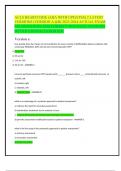Exam (elaborations)
ACLS HEARTCODE (AHA WITH UPDATES) 2 LATEST VERSIONS (VERSION A &B) ACTUAL EXAM 250 QUESTIONS AND CORRECT DETAILED ANSWERS WITH RATIONALES|AGRADE
- Course
- NURSING
- Institution
- California University Of Pennsylvania
ACLS HEARTCODE (AHA WITH UPDATES) 2 LATEST VERSIONS (VERSION A &B) ACTUAL EXAM 250 QUESTIONS AND CORRECT DETAILED ANSWERS WITH RATIONALES|AGRADE ACLS HEARTCODE (AHA WITH UPDATES) 2 LATEST VERSIONS (VERSION A &B) ACTUAL EXAM 250 QUESTIONS AND CORRECT DETAILED ANSWERS WITH RATIONALES...
[Show more]



